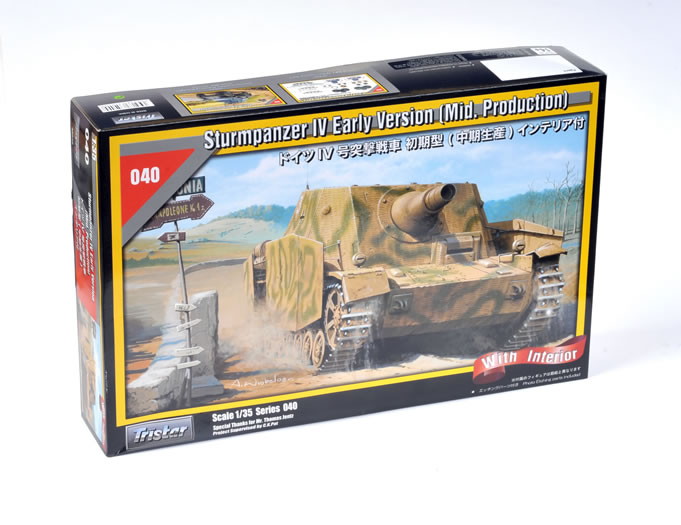|
|
|
|
| Home > Reviews > German > Tristar 1:35 Sturmpanzer IV Early Version (Mid Production) With Interior. Kit No. 040 |
Sturmpanzer IV Early Version (Mid Production) With Interior
Reviewed by Brett Green
Summary
| Stock Number and Description | Tristar 1:35 Sturmpanzer IV Early Version (Mid Production) With Interior. Kit No. 040 |
| Scale: | 1/35 |
| Media and Contents: | Tan coloured plastic, two parts in clear, Black plastic tyres for roadwheels, three photo-etched frets and markings for three vehicles. |
| Price: | MSRP USD$47.15 Distributed in USA by Pacific Coast Models |
| Review Type: | First Look |
| Advantages: | Excellent detail; full fighting compartment interior; beautifully presented suspension |
| Disadvantages: | No zimmerit |
| Recommendation: | Highly Recommended |
Background
The Editor examines the mid-production version of Tristar’s 1:35 scale Brummbar, which now includes a comprehensive interior.
The Sturmpanzer IV, also known as Sturmpanzer 43 or Sd.Kfz. 166, was an armoured infantry support vehicle based on the Panzer IV chassis used by Germany in the Second World War.
The Sturmpanzer IV was known by the nickname Brummbär. Contrary to popular belief, this name was applied by Allied intelligence and means "Grumbler", not "Grizzly Bear". The nickname which was not used by the Germans. German soldiers unofficially referred to it as "Stupa", a contraction of the term Sturmpanzer.
The Sturmpanzer IV was a development of the Panzer IV tank designed to provide direct infantry fire support, especially in urban areas. The result was the Sturmpanzer IV, which used a Panzer IV chassis with the upper hull and turret replaced by a new casemate-style armored superstructure housing a new gun, the 15 centimetres (5.9 in) Sturmhaubitze (StuH) 43 L/12 developed by Skoda. It fired the same shells as the 15 cm sIG 33 heavy infantry gun. Thirty-eight rounds, with separate propellant cartridges, could be carried. It used the Sfl.Zf. 1a sight. An MG 34 machine gun was carried that could be fastened to the open gunner's hatch, much like the arrangement on the Sturmgeschütz III Ausf. G.
Early vehicles carried a MP 40 sub-machine gun inside, which could be fired through firing ports in the side of the superstructure.
The driver's station projected forward from the sloped frontal armor plate and used the Tiger I's Fahrersehklappe 80 driver's sight. The fighting compartment was (badly) ventilated by natural convection, exiting out the rear of the superstructure through two armored covers. Sideskirts were fitted on all vehicles.
Early vehicles were too heavy for the chassis, which lead to frequent breakdowns of the suspension and transmission. Efforts were made to ameliorate this from the second series onwards, with some success.
In October 1943, it was decided that the StuH 43 gun needed to be redesigned to reduce its weight. A new version, some 800 kilograms (1,800 lb) lighter than the StuH 43, was built as the StuH 43/1. Some of the weight was saved by reducing the armor on the gun mount itself. This gun was used from the third production series onwards.
Zimmerit coating was applied to all vehicles until September 1944.
The Sturmpanzer IV was used at the Battles of Kursk, Anzio, Normandy, and helped to put down the Warsaw Uprising.
Four Sturmpanzer IVs survive today. They may be seen at the Musée des Blindés in Saumur, France, the Deutsches Panzermuseum in Germany, the Kubinka Tank Museum near Moscow and the United States Army Ordnance Museum near Aberdeen, Maryland. (Note 1)
F i r s t L o o k
Tristar released their early production version of the Sturmpanzer IV in mid-2008. This was a well-detailed and accurate kit, and generally acknowledged to be a landmark release. It featured a new one-piece lower hull and superb suspension.
Tristar has expanded on this already excellent release with the mid-production version of the Brummbar in 1:35 scale. In addition to the original kit parts, Tristar has now added an all-new and well detailed interior.
The new interior parts are supplied on three sprues. This interior includes a detailed gun breech and fighting compartment, spare shell stowage and radios. Driver’s compartment and transmission are not included. The driver’s vision block assembly is provided as a clear part. This should look great after careful masking and painting.
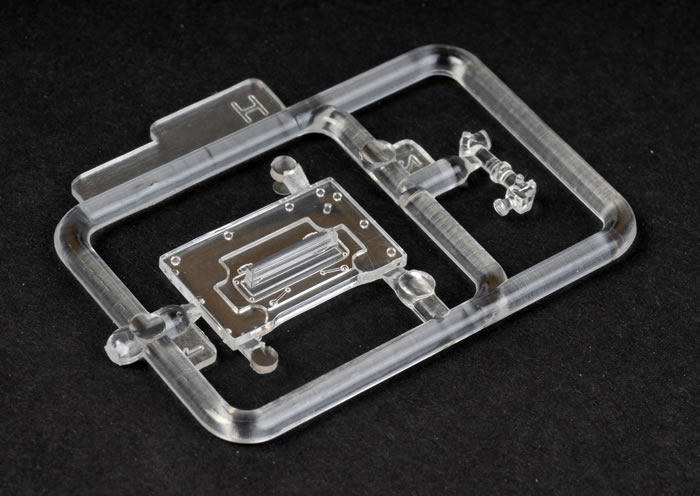
Three photo-etched frets supply even more detail for the interior and exterior, right down to the chains for the separate pistol ports.
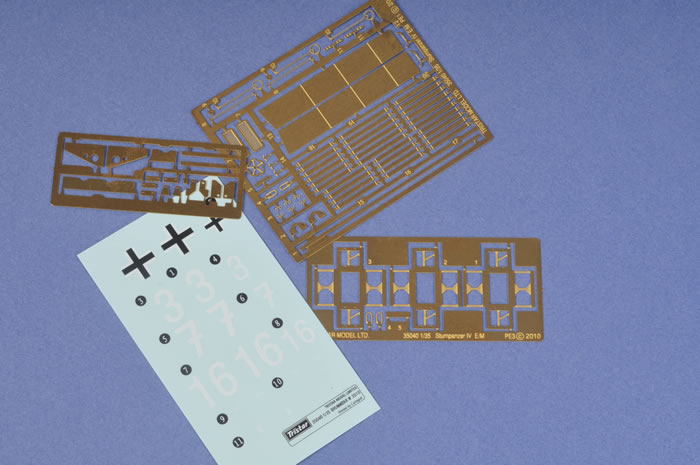
The thin laser-cut side skirts are hung from photo-etched mounts too.
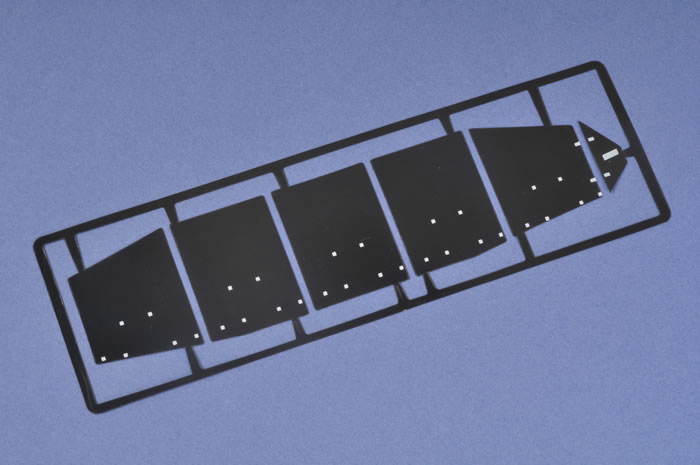
The one-piece lower hull will ease construction, while the multi-part superstructure should not present too many challenges to moderately experienced modellers.
This kit offers three marking options for Brummbars attached to Abt. 216 in Italy during 1944.
B u i l d i n g
Dennis Brandle presented his 1:35 scale Tristar early version Sturmpanzer IV in Issue 38 of Model Military International magazine. The majority of the exterior parts are the same in both kits, so his observations will be relevant to this instance too.
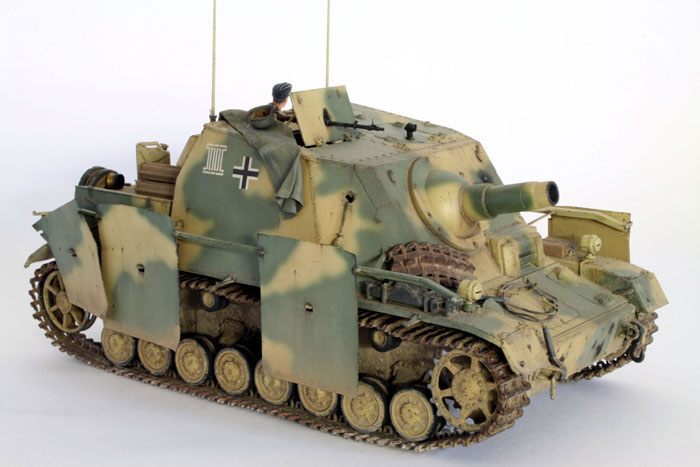
Dennis concluded that the Tristar kit was a more complex build than he expected – the multi-piece assembly of the armoured superstructure and the engine deck proved quite a challenge for someone who might be used to simple, single parts as in Tamiya and DML kits. The detail was good and even without any aftermarket items. There is no doubt that Dennis built a very good looking early Sturmpanzer IV.
C o n c l u s i o n
The two shortcomings in the original kit - the errors in the instructions and the missing interior – have both been addressed by Tristar in this release.
For modellers about to embark on any Brummbar project, make sure you check out Richard Hedrick’s Sturmpanzer.com website for some fabulous reference.
Note 1: Background information sourced online from Wikipedia http://en.wikipedia.org/wiki/Brummbär
Thanks to Tristar for the sample www.tristar-model.com

